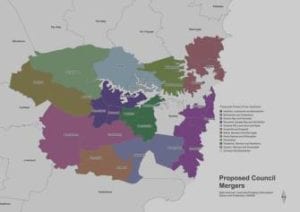Professional Associations
Is it good or bad for heritage? What is the purpose of the proposed council mergers and will there be benefits for the management of cultural built heritage at a local government level? Together with contributory items in NSW, Australia, there are approximately 40,000 heritage buildings and places in NSW that enjoy local government protection through listing on council registers. Personally, I have no doubt that these listings will continue to be protected despite the amalgamations. So what is the benefit? I can only think of two reasons.
My first reason for supporting council amalgamations is efficiency based on scale and momentum. It is a well-known fact that councils struggle to make ends meet financially (LGSA, 2006) and this is especially true of the rural councils. The inner-city councils around Sydney CBD are better off, but in terms of heritage services, they too continue to struggle against costs and limited budgets not to mention the problems associated with attracting suitable and experienced candidates to fulfil the role of ‘council heritage advisor’ – a mighty task demanding of a high level calibre of skills, understanding, knowledge and experience.

In a survey that I conducted in 2013 (Rappoport PhD research), I gleaned that the biggest problem amongst councils is that there is no consistency of approach between various councils when it comes to the administration of cultural heritage portfolios. And because of this, the outcomes are entirely unpredictable. Unpredictability and inconsistency of approach weakens the bonds of trust and faith that a community (owners and enjoyers of heritage places) has in its council especially when it becomes obvious that such approaches are highly subjective, unregulated and whimsical.
In the UK there is a local council code that regulates the management of heritage portfolios in local government and every local council is bound by it. The National Planning Policy Framework (UK, 2012) states that; in determining planning applications, local planning authorities should take account of;
the desirability of sustaining and enhancing the significance of heritage assets and putting them to viable uses consistent with their conservation;
the positive contribution that conservation of heritage assets can make to sustainable communities including their economic vitality; and
the desirability of new development making a positive contribution to local character and distinctiveness (Policy 131).

When considering the impact of a proposed development on the significance of a designated heritage asset, great weight should be given to the asset’s conservation. The more important the asset, the greater the weight should be. Significance can be harmed or lost through alteration or destruction of the heritage asset or development within its setting. As heritage assets are irreplaceable, any harm or loss should require clear and convincing justification. Substantial harm to or loss of a listed building, park or garden should be exceptional. Substantial harm to or loss of designated heritage assets of the highest significance, should be wholly exceptional (Policy 132).
Another policy states that local planning authorities should assess whether the benefits of a proposal for enabling development, which would otherwise conflict with planning policies but which would secure the future conservation of a heritage asset, outweigh the disbenefits of departing from those policies (Policy 140).
As the above policies indicate, the ground rules for assessing development in the context of heritage are laid out in the NPPF 2012 (UK) and proportionate weightings are given in order to guide heritage assessments and considerations of impact. In NSW, no such document exists. We do have the Burra Charter but that charter is rather weak and ill-defined on the issue of impact assessment and relates more to approaches and methodologies of conservation. It simply states that ‘minimal impact’ should be ensured but does not explain or equip the assessor with the necessary tools for evaluating benefits against potential loss (of views, significance, fabric or setting).

Thus, in the interests of efficiency and scale, I would support the amalgamations so long as a necessary policy document is provided with it to ensure consistency from one council to the next. The second reason upon which I would support council amalgamations is that it opens up a path for policy reform vis a vis the delivery of local government heritage services and administration of the portfolio of listed buildings.
There appears to be a number of issues plaguing the effective regulation of cultural built heritage at local and State government level in NSW. These may be listed as follows;
Incapacity and under-resourcing at local government level
Cost shifting onto the private sector
Lacklustre policy settings (innovation and incentives)
Deficient revenue base for local government
Failure by the whole of government to promote CBH as a public good in society
Unavailability of private and public funding mechanisms for the heritage sector
Failure to properly police and fine perpetrators of unauthorised work on heritage buildings
Conceivably, invigorated policy reform and innovation would benefit all three groups in the arrangement. Communities would get the benefit of having cultural built heritage as a public good in society; owners would get a greater financial assistance by way of incentives and government would get the benefit of a greater financial contribution by the private sector for its administration costs.
On this basis, I support council amalgamations.
Paul Rappoport – Heritage 21 – 21 June 2016
Reference
Burra Charter – the Australia ICOMOS Charter for Places of Cultural Significance, The Burra Charter, 2013 (Burra Charter).
Local Government and Shires Associations of NSW (LGSA), Are Councils Sustainable? Final Report: Findings and Recommendations – Independent Inquiry into the Financial Sustainability of NSW Local Government, May 2006.
National Planning Policy Framework, Department for Communities and Local Government, UK Government, Eland House, Bressenden Place, London, 2012
Rappoport PhD research – UNSW, 2013
Related Articles

Why doesn’t NSW adopt good design principles for heritage buildings?
There ought to be a qualification for all designs in relation to heritage buildings. Our heritage-listed items and buildings in…
Read more
Time to Rationalise our Heritage Conservation Areas (NSW)
The recent Not-In-My-Back-Yard (NIMBY) and Yes-In-My-Back-Yard (YIMBY) debate on social media and the tabloid press has highlighted the fragility of…
Read more
Five things you need to know about cultural built heritage
Historic conservation, writes Regina Bures (see reference below), is frequently associated with gentrification: the incursion of middle-class "gentry" on an…
Read more
Heritage, Gentrification, Urbanisation & Tourism
Historic conservation, writes Regina Bures (see reference below), is frequently associated with gentrification: the incursion of middle-class "gentry" on an…
Read more

Need help getting started?
Check out our guides.

Complete the form below to contact us today.









